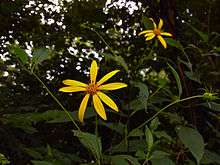Helianthus decapetalus
| Helianthus decapetalus | |
|---|---|
 | |
| Chesapeake & Ohio Canal National Historic Park, Washington | |
| Scientific classification | |
| Kingdom: | Plantae |
| (unranked): | Angiosperms |
| (unranked): | Eudicots |
| (unranked): | Asterids |
| Order: | Asterales |
| Family: | Asteraceae |
| Genus: | Helianthus |
| Species: | H. decapetalus |
| Binomial name | |
| Helianthus decapetalus L. 1753 not Darl. 1837[1] | |
Helianthus decapetalus, known by the common names thinleaf sunflower[2] and thin-leaved sunflower,[3] is a perennial forb in the sunflower family. It is native to the eastern and central United States and Canada, from New Brunswick west to Iowa, Wisconsin, and Ontario, south as far as Georgia and Louisiana.[4][5] It produces yellow composite flowers in late summer or early fall.
The name decapetalus means "with ten petals," referring to the 8-12 ray florets on the flower heads, resembling petals.
Description

The smooth slender stem of Helianthus decapetalus is 60 to 200 centimeters (2 to almost 7 feet) tall and branched near the top. The ovate or lanceolate leaves are borne on 2 to 5 centimeter long petioles and have serrated edges. They are 7 to 21 centimeters long and 4 to 10 centimeters wide. Helianthus decapetalus has 3 to 10 flowerheads. Each flowerhead is composed of 21 to 50 disk florets, and 8 to 12 ray florets, which are 2 to 2.5 centimeters long. The bracts are typically 11 to 16 millimeters long, surpassing the flower disk by at least half their length. The fruit are 3.5 to 5 millimeter long cypselae with a pappus of two scales.[6][7][8]
Distribution and habitat
In Virginia it grows in habitats such as floodplain forests and riverbanks.[9] The presence of this species is dependent on appropriate habitat, and it may be eliminated from an area by development, changes in land use, or competition with invasive species.
Ecology
The flowers attract many kinds of insects, including bees and butterflies, some of which, such as the Painted Lady and the Silvery Checkerspot, use the plant as a larval host. The seeds provide a source of food for birds.[10] Muskrats eat the leaves and stems and use the stems in the construction of their lodges.[8]
References
- ↑ The International Plant Names Index
- ↑ "Helianthus decapetalus". Natural Resources Conservation Service PLANTS Database. USDA. Retrieved 19 January 2016.
- ↑ "BSBI List 2007". Botanical Society of Britain and Ireland. Archived from the original (xls) on 2015-02-25. Retrieved 2014-10-17.
- ↑ Biota of North America Program 2014 county distribution map
- ↑ "Plants Profile for Helianthus decapetalus (thinleaf sunflower)". Retrieved January 24, 2014. USDA, NRCS. 2014. The PLANTS Database (http://plants.usda.gov). National Plant Data Team, Greensboro, NC 27401-4901 USA.
- ↑ Britton, Nathaniel Lord & Brown, Addison (1913). An Illustrated Flora of the Northern United States, Canada and the British Possessions: From Newfoundland to the Parallel of the Southern Boundary of Virginia, and from the Atlantic Ocean Westward to the 102d Meridian, Volume 3., p. 484. Charles Scribner's Sons, New York.
- ↑ "Helianthus decapetalus in Flora of North America @ efloras.org". Retrieved February 15, 2014. 'eFloras (2008). Published on the Internet (http://www.efloras.org). Missouri Botanical Garden, St. Louis, MO & Harvard University Herbaria, Cambridge, MA.
- 1 2 "Helianthus decapetalus (thin-leaved sunflower): Go Botany". Retrieved February 15, 2014. Copyright © 2011-2013 New England Wild Flower Society (http://www.newenglandwild.org)
- ↑ "Digital Atlas of the Virginia Flora | Helianthus decapetalus L.". Retrieved January 24, 2014. Virginia Botanical Associates. (2014). Digital Atlas of the Virginia Flora (http://www.vaplantatlas.org). c/o Virginia Botanical Associates, Blacksburg.
- ↑ "Ten-Petal Sunflower (Helianthus decapetalus)". Retrieved January 24, 2014. Copyright © 2002-2012 Dr. John Hilty. Illinois Wildflowers (http://www.illinoiswildflowers.info)